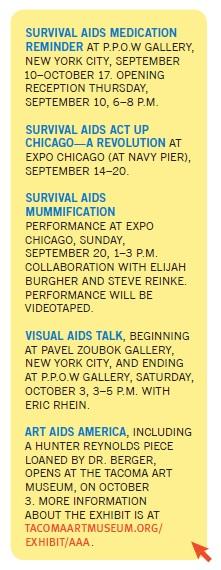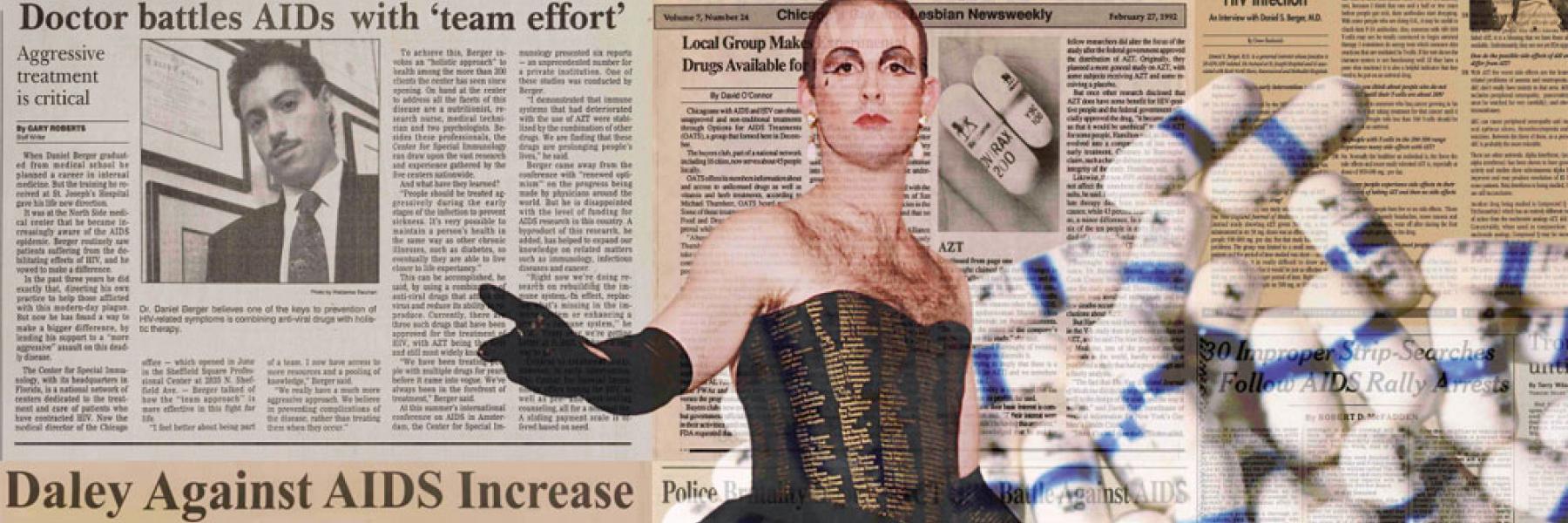
In September, an AIDS protest comes to Expo Chicago (the International Exposition of Contemporary & Modern Art). Not a protest of the show, but of AIDS itself—its politics and its illness. Its death toll.
“Survival AIDS ACT UP Chicago—A Revolution” presents a mummification performance by gay and HIV-positive artist Hunter Reynolds along with three wall-sized panels where he collages photographs on scanned newsprint of articles on the epidemic, including material from POSITIVELY AWARE.
Here, he uses archival material from the ACT UP collection at the University of Chicago and the private collection of Chicago HIV specialist Dr. Daniel S. Berger (see The Return of ART+ Positive), part of his series entitled Survival AIDS.
One panel features a photo of Patina Du Prey, Reynolds’ Shamanistic, gender fluid alter ego, wearing his AIDS Memorial Dress, created in 1993, silk-screened with 25,000 names of people who have died from HIV/AIDS.

“The sheer loss was the central theme of my work for 10 years in the ’90s,” said Reynolds. Patina Du Prey began in 1989 as “a way of dealing with the dragphobia in the gay community” and in the mid-’90s he used his studies in Sufism to perform with chanting and dervish dancing to express loss in the epidemic. He sensed a cathartic reaction from audiences and found himself at times “taking the energy” of their tears and their grief.
More recent are his mummification performances, like the one in Chicago, where his body is wrapped in cellophane and tape and he emerges as the “skin” is left on the floor. “Each one I do is about my body’s transformation,” said Reynolds, “transformation of life and survival.”
His work, he said, reflects his experiences as a gay man and as a person living with HIV, as well as AIDS activism. It’s how he came to understand collage as a new form of artwork for him following a stroke in 2005 that left one side paralyzed for months, with only three T-cells and a fungal infection in his brain. In that period, he looked through the collection of news articles he clipped from 1989–1993, and found inspiration.
“I needed to reinvent my whole process of making art,” he said. He has yet to regain the use of his right hand, or to paint again.
Reynolds hoped that the work might help “reignite interest” in the city’s former ACT UP members and others. He said the Chicago panels are “another opportunity to tell a new story in another place from the same time frame.”
“I always wanted to reflect socio-political issues,” said Reynolds.
That political motivation came before the HIV epidemic. As an art student, he protested against nuclear proliferation. After moving to New York City in the mid-80s, he joined ACT UP as soon as it started, where he co-founded the affinity group ART+ Positive to push back against homophobia, “AIDSphobia,” and censorship in the arts (see previous page). He later also became a member of Visual AIDS. He was still unaware of his own HIV-positive status, a diagnosis he wouldn’t receive until 1989. Because he was part of a gay men’s health study, however (which helped him obtain free medical care), he learned that he had actually become positive in 1984.
In his exhibit proposal, Reynolds wrote, “Through my layering of media and archives, I create historical and abstracted messages, infused with my own images to create a space within the work where experience and reporting, artist and audience, and present and past exist simultaneously.”


